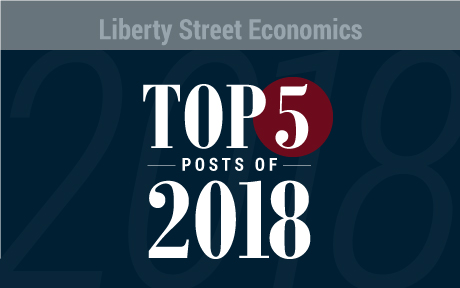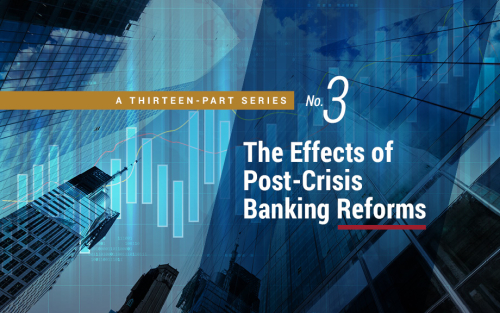Financial Fragility without Banks

Proponents of narrow banking have argued that lender of last resort policies by central banks, along with deposit insurance and other government interventions in the money markets, are the primary causes of financial instability. However, as we show in this post, non-bank financial institutions (NBFIs) triggered a financial crisis in 1772 even though the financial system at that time had few banks and deposits were not insured. NBFIs profited from funding risky, longer-dated assets using cheap short-term wholesale funding and, when they eventually failed, authorities felt compelled to rescue the financial system.
Did Subsidies to Too‑Big‑To‑Fail Banks Increase during the COVID‑19 Pandemic?

New Liberty Street Economics analysis by Asani Sarkar investigates whether the COVID-19 pandemic has led to an increase in implicit TBTF subsidies for large firms.
Did Too‑Big‑To‑Fail Reforms Work Globally?

Once a bank grows beyond a certain size or becomes too complex and interconnected, investors often perceive that it is “too big to fail” (TBTF), meaning that if the bank were to fail, the government would likely bail it out. Following the global financial crisis (GFC) of 2008, the G20 countries agreed on a set of reforms to eliminate the perception of TBTF, as part of a broader package to enhance financial stability. In June 2020, the Financial Stability Board (FSB; a 68-member international advisory body set up in 2009) published the results of a year-long evaluation of the effectiveness of TBTF reforms. In this post, I discuss the main conclusions of the report—in particular, the finding that implicit funding subsidies to global banks have decreased since the implementation of reforms but remain at levels comparable to the pre-crisis period.
Cryptocurrencies, Tariffs, “Too Big to Fail,” and Other Top LSE Posts of 2018

“Cryptocurrency” hit the cultural mainstream in 2018. In March, Merriam-Webster added “cryptocurrency” to the dictionary, and in what was perhaps a greater litmus test of pop culture recognition, “bitcoin” was added to the official Scrabble dictionary in September. With such a surge in interest, it’s not too surprising that the most viewed post on Liberty Street Economics this past year focused on an issue surrounding how digital currencies operate that is not often put in the spotlight—trust. Similarly, as the subject of tariffs has become a more frequent topic of discussion in the news, readers have sought additional info, which fueled interest in another of our most viewed posts of the year. As 2019 approaches, we offer a chance to revisit these posts and the rest of our top five of 2018.
Resolving “Too Big to Fail”

Many market participants believe that large financial institutions enjoy an implicit guarantee that the government will step in to rescue them from potential failure. These “Too Big to Fail” (TBTF) issues became particularly salient during the 2008 crisis. From the government’s perspective, rescuing these financial institutions can be important to avoid harm to the financial system. The bailouts also artificially lower the risk borne by investors and the financing costs of big banks. The Dodd-Frank Act attempts to remove the incentive for governments to bail out banks in the first place by mandating that each large bank file a “living will” that details its strategy for a rapid and orderly resolution in the event of material distress or failure without disrupting the broader economy. In our recent New York Fed staff report, we look at whether living wills are effective at reducing the cost of implicit TBTF bailout subsidies.
Fear of $10 Billion

Ten billion has become a big number in banking since the Dodd-Frank Act of 2010. When banks’ assets exceed that threshold, they face considerably heightened supervision and regulation, including exams by the Consumer Financial Protection Bureau, caps on interchange fees, and annual stress tests. There are plenty of anecdotes about banks avoiding the $10 billion threshold or waiting to cross with a big merger, but we’ve seen no systematic evidence of this avoidance behavior. We provide some supporting evidence below and then discuss the implications for size-based bank regulation—where compliance costs ratchet up with size—more generally.
Do “Too‑Big‑to‑Fail” Banks Take On More Risk?
In the previous post, João Santos showed that the largest banks benefit from a bigger discount in the bond market relative to the largest nonbank financial and nonfinancial issuers.
Evidence from the Bond Market on Banks’ “Too‑Big‑to‑Fail” Subsidy
Yesterday’s post presented evidence on a possible upside of very large banks, namely, lower costs.
Do Big Banks Have Lower Operating Costs?
Despite recent financial reforms, there is still widespread concern that large banking firms remain “too big to fail.”
The New Bank Resolution Regimes and “Too‑Big‑to‑Fail”
During the recent financial crisis, the absence of an orderly resolution regime forced governments of several countries to provide extraordinary support to a number of systemically important financial institutions (SIFIs) that were considered “too-big-to-fail.”










 RSS Feed
RSS Feed Follow Liberty Street Economics
Follow Liberty Street Economics